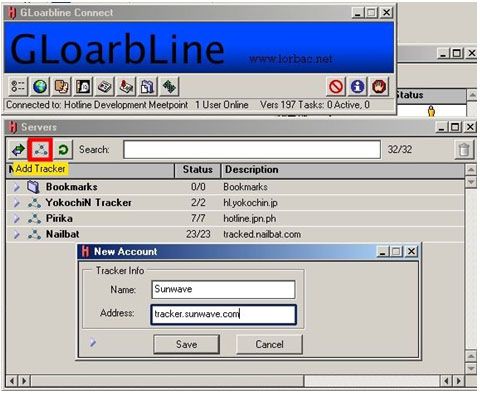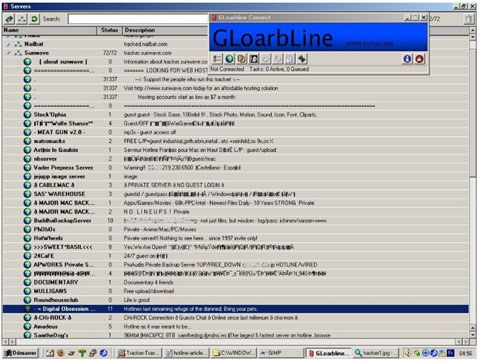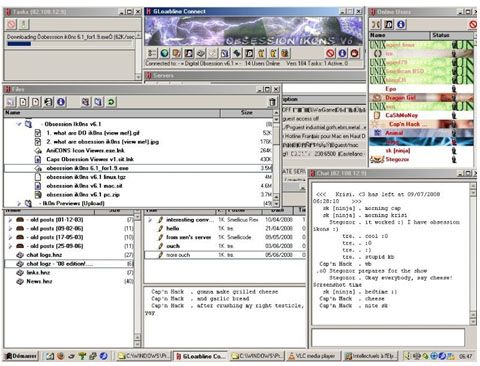July 10, 2008 by sharky
 Here at FSF, nothing gets us more pumped than the discovery of a new (or old) method for file sharing. It’s what we do. A reader of our blog, "Zig" being one of his favourite nicknames, came up with this article to enlighten us on this long-lost (but not forgotten) P2P protocol. Introducing Hotline - a thriving ‘underground’ peer-to-peer community of hard-core filesharers.
Here at FSF, nothing gets us more pumped than the discovery of a new (or old) method for file sharing. It’s what we do. A reader of our blog, "Zig" being one of his favourite nicknames, came up with this article to enlighten us on this long-lost (but not forgotten) P2P protocol. Introducing Hotline - a thriving ‘underground’ peer-to-peer community of hard-core filesharers.
First there were IRC, USENET and FTP for file sharing… And then Napster appeared, right? Well, not exactly. In the late 90s, another file sharing tool was highly popular: Hotline Connect, more commonly referred to as Hotline. Although no longer mainstream, it’s still used by some tight-knit groups of users to find what they look for. It was directly inspired by the BBS scene, but instead of a text user interface, it takes advantage of the GUI of modern operating systems; and provides, like any decent BBS, a message board similar to newsgroups, a public chat similar to IRC, private messaging and a file repository where users can browse folders and download and upload files. And like all BBSes, it is based on a client/server architecture (not P2P) with built-in support for resumable downloads, which means that traditional surveillance of peer to peer networks has no effect in this realm. So much for Mediadefender.
But let’s begin with a bit of history: It all started in 1996, when a talented Australian programmer, only 17 at that time, started coding Hotline on his Mac. After a while, he received an offer to move to Canada where Hotline Communications was incorporated, and work started on a Windows version to reach a wider user base. At that time, the application was distributed as shareware and adware, displaying advertisements on the banner of the main toolbar window. But unfortunately, soon after that, Hinks, the developer, and the company went in a major disagreement and the former took all the source code, encrypted what he couldn’t take with him and went back home to Australia. This of course halted the development for a long while and a bitter fight in court followed. The outcome was that Hinks lost all his copyright for this software and related libraries, but because of the dot com crash at that time and the distraction caused by the lawsuit, Hotline Communications went bankrupt. Its remains were bought by some of the previous staff and shareholders, who changed its name to HotSprings Inc and released Hotline’s source code under the GNU GPL. The problem was that the application was becoming more and more obsolete because of the lack of development and the competition from peer to peer networks, not to mention that many Hotline fans, still remembering the lawsuit, were backing Hinks and were reluctant to buy software not developed by him (some said stolen from him). HotSprings failed to release the long expected 2.0 version and went also out of business. Since then, everything relies on volunteer developers. That’s all for the history lesson, it’s time to get our hands dirty. Note that as mentioned above, Hotline was originally developed for Mac, and therefore there is a strong focus on Macintosh in the Hotline community even today.
Getting Started in Hotline
Since Hotline’s source code is now under the GNU GPL and the protocol specifications have been made public, there are many clones. You’ll first have to grab a client, the choice is yours. For this article, we chose GLoarbLine, directly derived from the original client with its Mac OS 9 look. Note that it supports neither the right button of the mouse nor the wheel, but if this is a problem, you can chose another client such as PhareRouge-GL, a cross platform, open source client/server written in Java. When you have it on your computer, the first thing you’ll have to do is to enter a nickname and choose an icon that other users will see on the user list. Of course, there are additional icon sets you can find on various Hotline servers, but you’ll find a good collection to begin with by default. When this is done, you’ll have to add a tracker so that your client is able to show you a list of available servers. Note that not all trackers list all servers, and not all servers are necessarily referenced on a tracker. To find a list of available trackers, the best place is http://www.tracker-tracker.com, which is, as the name suggests, a tracker of trackers (please remember what happened to IRC Klipper and don’t forget to click on the ads).
This service also provides a search engine to look for files on Hotline servers. It simply uses a bot which connects regularly to all servers it can access, checks them, indexes their files if the admins allow it to do so, and keeps an up to date database. For this example, we chose tracker.sunwave.com, run by http://www.sunwave.com.
When you have the URL of your tracker, click on the widget right before it’s name to see referenced servers. First come their name, then the number of connected people, and then a short description, often with the login and password for guest access. A login and a password? Indeed… Hotline is not only about file sharing, first of all it’s a community thing. Each server has its own flavour (those using Direct Connect and OpenNap already know what we’re talking about); and although you’re free to have a look, you’ll need an account to get full access. Then again, it depends on each server: some are free for all, others ask for requests to be filled to provide an account, others require a small donation to cover hardware and bandwidth costs, on some other servers the admin has to fall in love with you. Some are private or invitation only, others only provide commercial back up services for important data, and some servers do not even focus on file sharing but only on chatting. In all cases if there’s a guest login and password in the description, you’ll have to enter this in the appropriate dialog box as with the tracker. In other cases, a double click should be enough to get you connected.
Once you’re in, you should join the public chat and read the news (similar to the newsgroups) before rushing on files. On servers which do not provide a guest login and pass on the description, their access rules are often mentioned on the message board, so in most cases rushing for files will only mean that you’ll have to come back to the message board anyway, after seeing that you don’t have required permissions to download: as anywhere else, leechers and freeloaders are not welcome on Hotline. These boards also contain topics such as the latest news regarding the server like downtimes, sharing week-ends (basically “I share you share - no shit - finish your downloads – don’t upload stuff already there — look to the offline folder also” stuff), member requests, and download and upload speeds posted by members. To make it short, it’s not only about typing a file name in a search box and start downloading but taking the time to find the right server, to get used to its customs, to honor members’ requests. Needless to say, this is only a basic introduction, but from this point on you should be able to find out more by playing around. Moreover, detailed guides in PDF format at Nailbat.com will have an answer for most of your questions. If still in trouble, the best place is, of course, a friendly Hotline server.
Here’s a screenshot to show how GLoarbLine at work looks like, with almost all windows open (main window, servers, chat, news, files, tasks, and user list):
When you get used to the client side, nothing prevents you from starting your own server in a couple of minutes: as an administrator, you’ll then have total control on who can access, who can download and who can just take a look, possibilities are nearly endless. For small communities, this provides several advantages: Hotline protocol not being in mainstream use, it’s not filtered at all, the server can remain fully private with no search engine even trying to index it as long as you don’t add it to trackers, and files do have a central, stable location on which they are stored. No swarming, but no unstable peers fading away with no warning during the night either… All this to say that each method has its up and downsides and Hotline is no exception to the rule, but it adds yet another choice for those who’d like to share files with their neighbours. For more information on Hotline, a list of client and server software and a collection of interesting links, we recommend the relevant category of the Open Directory Project (aka dmoz).
And to bring this article to an end, we’d like to mention that there is a noticeable demand for a new client with new features such as end-to-end encryption, support for files over 2 GB and a skinnable interface - to mention a few. So if you have coding skills and would like to give a hand, feel free to take a look at VivaHX and to the Hotline Development Meetpoint (this is a hotline link, you need to have GloarbLine to enable the protocol handler) where you can find all the source and documentation along with friendly people to get started. Happy sharing!


